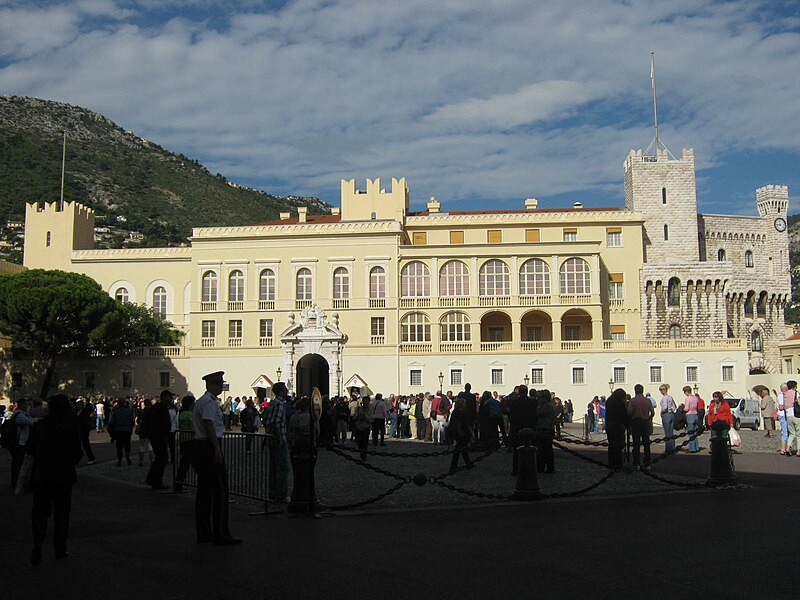by Scott Mehl © Unofficial Royalty 2015

source: Wikipedia, Hans1967
The Prince’s Palace of Monaco
Located atop “Le Rocher” (the rock) in Monaco-ville, The Prince’s Palace is the home of The Sovereign Prince of Monaco and his family, as well as the seat of the Monegasque monarchy. It has been home to the Grimaldi family for over 700 years.
The Palace began as a Genoese fortress built in 1191. In 1297, Francois Grimaldi, disguised as a monk, managed to gain entrance and took control of the fortress. Thus began a long history of the Grimaldi family, who eventually became Lords, and then Princes, of Monaco.
Over the next 650 years, the palace transformed through the addition of buildings and wings, becoming more of a place, and less of a fortress. Much of this took place during the reign of Honore I (1523-1581), who built much of the existing palace. Honore II, the first Prince of Monaco (1604-1662), added the eastern wing which overlooks the Palace Square and extended the State Apartments, as well as building the beautiful staircase in the courtyard. He also began the extensive collection of art and tapestries which adorn the palace.
By the time of the accession of Prince Rainier III in 1949, the palace was in need of major repair and restoration. Rainier undertook the massive project, and along with his wife, Princess Grace, turned the palace into the royal showplace that we know today. In addition to overhauling all of the state and official rooms, he also rebuilt the formerly demolished southern wing which houses the private apartments.

Religious wedding of Prince Albert and Princess Charlene in the palace courtyard, July 2011. source: The Daily Mail
The palace today is the working home of the Prince and Princess and is where all official ceremonies and functions take place. In addition, the people of Monaco are often invited to the palace on special occasions. Each year, the annual children’s Christmas party is held in the palace courtyard, as well as concerts of the Monte-Carlo Philharmonic Orchestra. The palace courtyard was also the site of the religious wedding ceremony of Prince Albert and Princess Charlene in 2011.
On the southern side of the courtyard is the magnificent double-revolution staircase, inspired by the staircase at the Palace of Fontainebleau in France. At the top of the Staircase is the Hercule Gallery which runs the length of the courtyard, and is adorned with frescoes of mythological figures, from the 16th and 17th centuries.
The State Rooms, located in the southern wing, begin with the Hall of Mirrors, which is used for visiting royalty and Heads of State. Inspired by the Mirror Gallery at Versailles, the room’s mirrors give the impression of a much larger space.
The Red Room, adorned with red silk brocade, is decorated in the Louis XV style and leads to the York Room. The York Room is a state bedchamber that gets its name from Prince Edward, The Duke of York and Albany (younger brother of King George III of the United Kingdom). The Duke was aboard a ship bound for Genoa when he fell ill in the summer of 1767. The ship took port in Monaco and the Duke was brought to the palace, where he died in this room on September 17, 1767. The York Room contains the marble mosaic table which is used to sign all official documents by the Sovereign Prince.
The Officer’s Room is used by court officials to greet guests before an audience with the Prince. It adjoins the Blue Room, adorned with blue silk brocade, which is used for official receptions.

The Throne Room, in preparation for the civil marriage ceremony of Prince Albert and Princess Charlene, July 2011. source: The Daily Mail
The Throne Room has been the site of all state ceremonies since the 16th century. The throne sits on a dais beneath a red silk canopy, surmounted by a gilt throne. The frescoes in the room depict the surrender of Alexander the Great. The Throne Room was the site of the civil marriage ceremony of Prince Albert and Princess Charlene in July 2011. The photo above shows the marble mosaic table which is normally kept in the York Room.
Other rooms include the Mazarin Room, the Louis XII bedchamber and the State Hall, which connects the eastern and southern wings of the palace and leads to the dining room and the private apartments of the Princely family.
This link to the official site of the palace includes photos of several of the State Rooms.
Learn more about other Monegasque Royal Residences here!
This article is the intellectual property of Unofficial Royalty and is NOT TO BE COPIED, EDITED, OR POSTED IN ANY FORM ON ANOTHER WEBSITE under any circumstances. It is permissible to use a link that directs to Unofficial Royalty.
